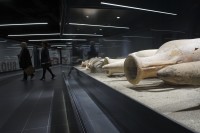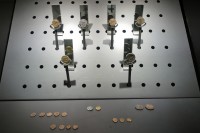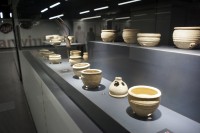 After six years of delays caused by constant archaeological discoveries, the first station of Rome’s new Metro C line is complete. The San Giovanni station near the Papal Archbasilica of St John in Lateran was unveiled to the press this week. The subway stop won’t be open to the public until the end of the year at the earliest because the rest of the line is still under construction. The station’s atrium museum was opened to the public on April 1st of this year, but that was just for the one day. It’s not clear whether visitors will be able to enjoy the exhibits before the official opening of the San Giovanni subway station.
After six years of delays caused by constant archaeological discoveries, the first station of Rome’s new Metro C line is complete. The San Giovanni station near the Papal Archbasilica of St John in Lateran was unveiled to the press this week. The subway stop won’t be open to the public until the end of the year at the earliest because the rest of the line is still under construction. The station’s atrium museum was opened to the public on April 1st of this year, but that was just for the one day. It’s not clear whether visitors will be able to enjoy the exhibits before the official opening of the San Giovanni subway station.
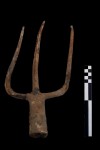 The construction of the San Giovanni station beginning in 2011 unearthed a vast swath of the city’s history, from prehistory to the modern era. The richest finds date to the late Republic and early Imperial era, with the most extraordinary features discovered on a 1st-3rd century A.D. commercial agricultural concern 20 meters (65 feet) below the surface, the closest ever found to the center of the ancient city. Archaeologists discovered farming-related artifacts including a three-pronged iron pitchfork, woven baskets, and leather fragments, possibly from a shoe or glove. The farm’s engineering was evidenced in grooves carved deep into
The construction of the San Giovanni station beginning in 2011 unearthed a vast swath of the city’s history, from prehistory to the modern era. The richest finds date to the late Republic and early Imperial era, with the most extraordinary features discovered on a 1st-3rd century A.D. commercial agricultural concern 20 meters (65 feet) below the surface, the closest ever found to the center of the ancient city. Archaeologists discovered farming-related artifacts including a three-pronged iron pitchfork, woven baskets, and leather fragments, possibly from a shoe or glove. The farm’s engineering was evidenced in grooves carved deep into 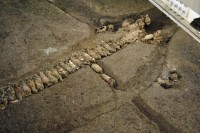 stone from the many turns of a long-decayed waterwheel, and in recycled amphorae, their ends cut open to be nested into each other in long lines for use as water channels. Archaeologists also found a huge hydraulic reservoir (115 feet by 230 feet), the largest ancient Roman water basin ever found, dating to the 3rd century A.D.
stone from the many turns of a long-decayed waterwheel, and in recycled amphorae, their ends cut open to be nested into each other in long lines for use as water channels. Archaeologists also found a huge hydraulic reservoir (115 feet by 230 feet), the largest ancient Roman water basin ever found, dating to the 3rd century A.D.
“It’s so big that it goes beyond the perimeter of the (metro) work site and it has not been possible to uncover it completely,” [excavation head Rossella] Rea explained. “It was lined with hydraulic plaster and, on the basis the size that had been determined so far, it could hold more than four million litres of water”. […]
“It seems likely that its main function was to be a water reservoir for crops and an area that made it possible to cope with overflows from the nearby river. No other basin from ancient Roman agriculture is of comparable size. Beyond the walls of the work site it extends toward the (ancient city) wall, where it is probably preserved”.
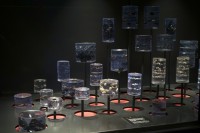 San Giovanni’s massive archaeological endowment didn’t stop there. A surprising number of well-preserved archaeobotanical remains were recovered, among them seeds, nuts, and the roots and stumps of willows and other trees. A number of peach pits were also discovered, likely the remnants of the farm’s orchards. Peaches are not native Roman fruits — these probably originated in Persia — and even in the Imperial era they were still considered an expensive, exotic import. It indicates that the farm was used to produce luxury foods, likely for the Imperial table.
San Giovanni’s massive archaeological endowment didn’t stop there. A surprising number of well-preserved archaeobotanical remains were recovered, among them seeds, nuts, and the roots and stumps of willows and other trees. A number of peach pits were also discovered, likely the remnants of the farm’s orchards. Peaches are not native Roman fruits — these probably originated in Persia — and even in the Imperial era they were still considered an expensive, exotic import. It indicates that the farm was used to produce luxury foods, likely for the Imperial table.
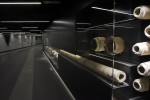 And that’s just scratching the surface of what was found during the San Giovanni dig. More than 40,000 artifacts were unearthed (hence the half a decade of delays): ancient pottery, coins, oil lamps, delicate glass perfume bottles, baked clay pipes, lead pipes, architectural elements, sculptures, reliefs, colorful dishware from the 17th through 19th centuries and on and on. The station museum displays a broad selection of these treasures in spacious, well-lit display cases.
And that’s just scratching the surface of what was found during the San Giovanni dig. More than 40,000 artifacts were unearthed (hence the half a decade of delays): ancient pottery, coins, oil lamps, delicate glass perfume bottles, baked clay pipes, lead pipes, architectural elements, sculptures, reliefs, colorful dishware from the 17th through 19th centuries and on and on. The station museum displays a broad selection of these treasures in spacious, well-lit display cases.
 The station has been ingeniously designed to take advantage of its subterranean location to create an immersive time machine experience for travelers and visitors. Riders enter the station today, then as they descend towards the train platforms, they pass through the Middle Ages to the Rome of the Emperors to the Republic all the way back to the Pleistocene. Artifact exhibits and information panels accompany you as you time travel, marking important dates in the city’s history.
The station has been ingeniously designed to take advantage of its subterranean location to create an immersive time machine experience for travelers and visitors. Riders enter the station today, then as they descend towards the train platforms, they pass through the Middle Ages to the Rome of the Emperors to the Republic all the way back to the Pleistocene. Artifact exhibits and information panels accompany you as you time travel, marking important dates in the city’s history.
